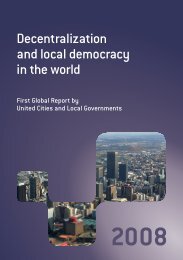Making Cities Resilient Report 2012
Making Cities Resilient Report 2012
Making Cities Resilient Report 2012
You also want an ePaper? Increase the reach of your titles
YUMPU automatically turns print PDFs into web optimized ePapers that Google loves.
CHAPTER 3 | Key Trends on Resilience-Building in <strong>Cities</strong><br />
KEY TRENDS ON RESILIENCE-BUILDING IN CITIES<br />
There response to urban risk varies widely at city level, depending on the<br />
environmental context, the size of the city, and the stage of the city’s<br />
development. A comparison of how cities are addressing risk offers unique<br />
insight into the meaning of resilience at city level – how it is understood and<br />
how it is implemented – with notable differences in the type of activities<br />
undertaken by cities in different environmental and developmental contexts,<br />
and those at the early versus more advanced stages of resilience building.<br />
This section explores some of the key trends emerging, based on the<br />
activities cities are pursuing.<br />
Across all the cities analysed in this report, the five types of activities occurring most frequently are:<br />
1. Taking disaster risk reduction into account in new urban planning regulations, plans and<br />
development activities;<br />
2. Establishing councils/committees/disaster management structures dedicated to disaster risk<br />
reduction;<br />
3. Constructing hazard-resistant infrastructure or improving existing facilities;<br />
4. Establishing education/awareness/training programmes;<br />
5. Organizing multi-stakeholder dialogues.<br />
Another important trend is the extent to which cities are integrating disaster risk reduction into other<br />
local government activities, including education, livelihoods, health, environment, and planning, either by<br />
incorporating risk considerations into existing activities or initiating projects that address multiple issues<br />
simultaneously. This trend is noteworthy for those who identify the reduction of baseline vulnerability<br />
factors as a prerequisite to resilience (see Wisner et al 2004).<br />
Early versus advanced resilience-building activities<br />
Among the responses observed in cities at the early stage of resilience building is the creation of new disaster<br />
risk reduction committees or working groups that provide a dedicated space to discuss risk issues.<br />
An example is in Rwanda, where UN-Habitat has assisted the central government to roll out a national programme<br />
institutionalizing disaster risk committees in self-selecting urban municipalities. Other activities<br />
taking place among cities at early stages of resilience building include:<br />
• Undertaking risk assessments (Pune)<br />
• Applying simple structural solutions to mitigate hazard impacts (Siquirres)<br />
• Taking environmental protection measures such as tree planting or wetland conservation (Kampala)<br />
• Writing city development plans (Thimphu).<br />
Read more about what these cities are doing in Chapter 4.<br />
<strong>Making</strong> <strong>Cities</strong> <strong>Resilient</strong> <strong>Report</strong> <strong>2012</strong> | 33

















